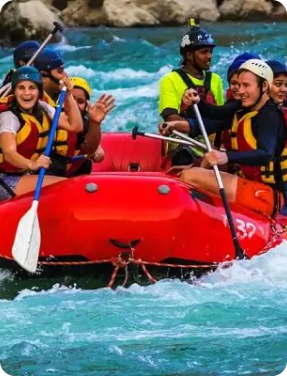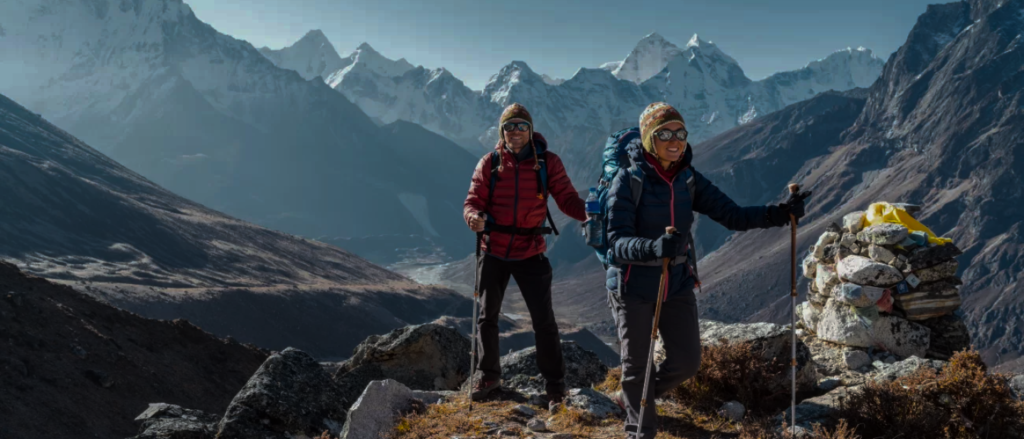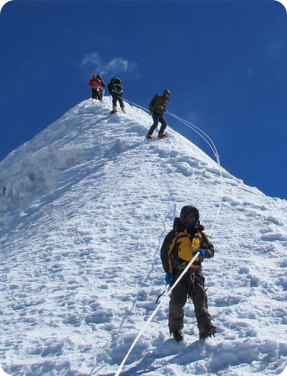Mt. Everest Expedition
Mt. Everest Expedition

Talk With Expert
- +977-1-5591234 / 9851104568
- info@prestigeadventure.com / pdamber@yahoo.com
OVERVIEW
Mount Everest is the world’s highest mountain and has attracted many climbers since its first summit in 1953 by Tenzing Norgay Sherpa and Edmund Hillary. Climbing Mount Everest is considered one of the most difficult feats in mountaineering. The climb includes a variety of obstacles, including steep slopes, huge ice walls as well as hidden crevasses and sudden weather changes.
The Everest expedition is both challenging and exciting. There is no doubt that Mount Everest is one of the most difficult mountains to climb; Many experienced climbers have tried and failed for various reasons. Being unprepared is never an option when conquering an 8,000m peak and especially for Mt. Everest Moutain. Climbing experience, fitness, mindset, suitable equipment, qualified team and luck are the factors that help you climb successfully. If possible, we recommend climbing Mount Manaslu or Mount Cho Oyu to prepare for your Everest attempt.
ITINERARY
-
Day 01 Arrival Kathmandu
To check in at the hotel, our personnel will pick you up from the airport and drive you there. You will receive a trip briefing from our staff, which will also get you ready for the adventure. The hotel is a great place to unwind and spend the night.
-
Day 02 Kathmandu Sightseeing
The Kathmandu valley will be visited on a sightseeing trip led by a knowledgeable local guide. In Kathmandu, you will see a number of World Heritage Sites, such as Boudhanath, Swayambhunath, and several Durbar Squares in the Kathmandu Valley. These structures have a significant cultural and historical value. You will gain first-hand knowledge of the Newar community’s culture, architecture, and culinary traditions. On your way back to your accommodation that night.
-
Day 03 Shopping and trip preparation
You will meet the team leaders and other climbers in a team meeting that we will set up. Climbers with years of experience will give you a briefing about the purpose of the adventure, the tools, and the team members. Any personal stuff that you could require during your stay at the Himalayas can be purchased. The items you brought will be examined by professionals to see if they are practical and in excellent working order. The equipment may need to be replaced if it doesn’t meet the required standards.
-
Day 04 Official briefing in the Ministry of Tourism
There will be a formal briefing with the government representatives from the Ministry of Tourism. You will receive a briefing there on the official policies and protocol of the Everest trek.
-
Day 05 Fly to Lukla and trek to Phakding (2640m)
We’ll take an exciting flight from Kathmandu to Lukla. With only 527 meters of a runway, the Tenzing Hillary Airport is one of the tiniest airports in the world. The journey gets off to the ideal start with the exciting beginning. We will begin our trip to Pkhading from Lukla. Up until you get in the settlement of Phakding, the clearly designated track travels above the Dudh Kosi valley.
-
Day 06 Trek from Phakding to Namche Bazaar (3446m)
From Phakding, the walk to Namche Bazaar begins early. The Dudh Koshi River runs along the trail, and we’ll cross the renowned Hillary suspension bridge. Along the trek, we may take in the vista of Mt. Thamserku (6618m). To get to the Sagarmatha National Park entrance, we go through the lovely villages of Jorsale and Monjo. To reach the confluence of the Dudh Koshi and Bhote Koshi rivers, the path travels through alpine woods and across water streams. After navigating the ridge at the Lhotse Nuptse junction, we arrive in Namche Bazaar. In the vicinity of Mount Everest, Namche is a well-known trade hub. In a guest home in Namche, we spend the night.
-
Day 07 Acclimatization and rest at Namche Bazaar
In order to acclimate our bodies to the high altitude, we do so in Namche Bazar. However, we continue to move and don’t stand still. We trek to Thame, go to Khunde, or wander about Namche Bazaar. The Khumbu region’s major hub, Namche Bazar, features a large number of cafes, government buildings, banks, etc. In order to effectively acclimatize, we hike a few hundred vertical feet.
We can go to the Sir Edmund Hillary-founded Khunde hospital or the Sherpa Cultural Museum. The Syangboche Airstrip and the Everest View Hotel are both accessible through a little trek. You will be mesmerized by the breathtaking views of the entire Himalayan range, including Everest, Nuptse, Lhotse, Ama Dablam, Thamserku, and Kusum Kangaru.
-
Day 08 Trek from Namche Bazaar to Tengboche (3800m)
We begin our climb towards Pangboche after breakfast while taking in breathtaking views of Mt. Everest, Nuptse, Lhotse, and Ama Dablam. Rhododendron trees line the route, which looks out towards the lofty Himalayas. Wild creatures like musk deer, Danphe pheasants, or a herd of Himalayan Thar might be seen.
Finally, we reach Sansa, the major trail intersection leading to Gokyo valley and Everest Base Camp. After that, the walk continues through pine trees until we arrive at Tengboche. In Tengboche, we spend the night.
-
Day 09 Trek from Tengboche to Pheriche (4243m)
We set off early on our journey from Tengboche to Pheriche. As the height goes beyond 4000m, severe ascents are the first thing we experience. Small towns with chortens and mani walls are among those we pass. The route gradually descends to Dingboche, where we use a suspension bridge to cross the Imja river. On our way to Pangboche, we ascend past mani stones. We will proceed to the oldest gompa in the area at Pangboche. Finally, the route ascends to Pheriche. In Pheriche, there is a medical center that can assist hikers in recovering from altitude sickness.
-
Day 10 Trek from Pheriche to Lobuche (4930m)
Our journey to Everest Base Camp continues. We’ll get to Dughla, which is nestled beneath the Khumbu glacier. The Dughla memorial honoring all Sherpas who lost their lives climbing Everest is visible. We continue our hike into a strenuous ascent up the glacier moraine after lunch at Dughla. The trek eventually takes us to a charming collection of tea houses in Lobuche after a number of hours.
-
Day 11 Everest Base Camp (5360m) – Camping Accommodation
We started our trek early from Lobuche to Everest Base Camp via Gorak Shep and Kalapatar. After breakfast, we will hike up the rocky moraine path above the valley. We can observe the frozen ponds and icebergs of the Khumbu glacier. A short descent will take you to Gorak Shep. Gorak Shep was the original site where Edmund Hillary and Tenzing Norgay set up their camp. A gradual walk on the rocky path and a half-hour climb will take you to Kalapatar. A panoramic view of the Himalayas awaits you at Kalapatar. We will rest and take as many photos as possible. The stunning close-up view of Mount Everest with Mount Nuptse and Mount Lho-la will leave you spellbound. The breathtaking view of the snow-capped mountains is a memory you will cherish for a lifetime. We will continue the trip after resting at Everest Base Camp. This road crosses the ice caps and crevasses of the Khumbu Glacier. Everest Base Camp will be bustling with other climbers from many other expedition groups. Colorful tents against the background of snow-capped mountains look extremely beautiful. We’ll pitch a tent and stay. This place will be our home for the next few months.
-
Day 12 to 60 Climbing Period Mt. Everest (8848m)
This route is technically a hiking route with little danger as you pass the Khumbu Icefall.
However, there are a number of crevices and stepped gullies and some short cliffs around Camp 3, as well as sections of rock protected by landline telephone lines. Complications from altitude sickness can be fatal. Weather in the mountains can sometimes be unpredictable and changeable.
The most dangerous part of the climb is the Khumbu Icefall. This is a steep glacier with a significant presence of large crevasses and unstable bloodlines. This obstacle complicates travel and increases the objectively high risk of falling ice. Sherpas will facilitate the climbing process by setting up ladders through crevasses and along the vertical ice walls of the mountains at the start. This process will determine the route through the icefall and make climbing efficient, safe and effective.
The climb to the top was done early in the morning because the ice was well frozen. Intense afternoon sunlight warms the area, reducing friction between ice structures and increasing the likelihood of cracks opening or ice blocks falling. This important factor makes conquering the Khumbu Icefall quite dangerous in the afternoon.
We set off as early as possible to avoid the strong afternoon winds at the summit. Mountaineering experts from our team will guide you and coordinate the expedition. Sherpa guides will help us by carrying our equipment. There will be a total of four camps set up during the climb to the summit.
Camp 1 : 6400m (20996 feet)
Camp 1 is located on top of the Khumbu Icefall. There is a thick layer of horizontal snow surrounded by mountain walls. The weather is hot during the day and cold at night due to strong winds blowing across the mountains. The glacier between camp 1 and camp 2 is flat. Large cracks near Camp 1 were repaired using ladders. A cracking sound was heard under the tent. Camp 1 is a place to rest and transition before moving to Camp 2.
Camp 2 : 6750m (22145 feet)
Camp 2 was set up at the base of the Lhotse wall or lateral moraine at the base of the western ridge. This is a safe and sheltered place with breathtaking views of Mount Lhotse. The camp will include individual tents, kitchen tents and dining rooms. Camp 2 is also the main acclimatization camp and the basis for the acclimatization process to Camp 3.
Camp 3 : 7100m (23292 feet)
Camp 3, attached to the Lhotse bulkhead, is made of fixed ropes. The climb will then take us to the summit of Geneva to the east. Oxygen levels will decrease rapidly at this altitude. In case of inconvenience, additional oxygen is available. However, most climbers will not need supplemental oxygen until Camp 4. The glacier is crossed from the right side, with the 600m climb at a 40-degree angle over the snow. The route is safe with some cliffs less than 3m high.
Camp 4 : 8,400 m (27,560 ft)
The last camp before the summit is camp 4. Located on the south col, Camp 4 is also the most dangerous climb. It is only 450 meters from the top of the mountain. The wind here is very strong and fierce. The narrow ridge to the southeast is the best route to the summit. From this road you can easily reach Mount Everest 8848m (29028 ft). Sir Edmund Hillary and Tenzing Norgay traveled this route in 1953.
The climb
-
Day 61 Trek from Everest Base Camp to Pheriche
We shall descend to Pheriche village. We will be walking downhill, therefore the pace of the journey will naturally be quicker. There will be an almost 1000-meter elevation difference. If we were acceding, such a significant elevation change would not have been conceivable. At Perche, we’ll take a nap and stay the night.
-
Day 62 Trek from Pheriche to Namche Bazaar
On the trip from Periche to Namche Bazaar, we shall decend a staggering 20 kilometers. We will be descending for the most of the longest hike of our tour, which will be simple. As we descend, the oxygen levels rise, allowing us to breathe more easily and causing altitude sickness to gradually subside. To go to Namche Bazaar, we will drive through a number of notable locations, including the Tengboche monastery. You may expect a hot shower and wifi in Namche. You’ll spend the night in Namche Bazaar.
-
Day 63 Trek from Namche Bazaar to Lukla
We will go past the settlement of Phakding on our way back to Lukla. It might be a difficult fall from Namche to Dudh Koshi. Your core will be put to the test by the constant slopes. The route will flatten out somewhat once you’ve crossed the suspension bridge. For the last time, we stroll through rhododendron forests while admiring the snow-capped Alps. In Lukla, we’ll spend the night at a lodge.
-
Day 64 Fly from Lukla to Kathmandu
After departing from Lukla, you will have an exhilarating flight back to Kathmandu while taking in one more view of the snow-capped Himalayas.
-
Day 65 Kathmandu rest/free day
A day off is scheduled for you in Kathmandu. In Thamel, a popular tourist destination in Kathmandu, you may do some last-minute shopping or unwind. The successful conclusion of the mission will be marked with a celebration meal that night.
-
Day 66 Final Departure
We’ll drop you off at the airport so you can catch a trip home or to anywhere you’d like to go.
COST
WHAT IS INCLUDED
-
- 04 nights Hotel in Kathmandu in 3-star standard on B/B Basis.
- During the trekking up to BC & return accommodation & food in local lodge.
- Food & camping at Base Camp for Member & Staffs.
- Expedition Permit (Sharing basis) National Park fee.
- 1 Tent per climber at Base Camp.
- 2 Base camp staff (1 cook & 1 Kitchen Boy).
- 1 Liaison Officer (Sharing Basis) with his daily wages, equipment & Insurance.
- Above mentioned staff’s daily wages, equipment allowance & Insurance.
- 10 porters (30Kg. Per porter) up to Base Camp per member including food & equipment.
- 8 porters (30Kg. Per porter) return from Base Camp per member including food & equipment.
- Flight: Ktm-Lukla -Ktm, for member & Sherpa Staffs.
- Cargo fees: Ktm- Lukla- Ktm.
- Cargo clearance & Duties fee.
- One Gamo bag & Solar panel
- All ground transportation as per itinerary.
- Farewell Nepali Dinner
- Arrival / departure transfers.
WHAT IS EXCLUDED
-
- Personal equipment & Insurance. (Including Helicopter evacuation)
- Climbing Sherpa
- Oxygen 4 lts. (Climber require 4 btls & Sherpa require 3 btls)
- Mask & regulator Per set on Rent
- Per Sherpa Climbing Summit Bonus and non-summit bonus
- High Altitude Food, Tent & Equipments for Member & Sherpa.
- Lunch and dinner during Kathmandu stay.
- Alcohol, beverages, Telephone call, laundry, Nepal visa fee.
- Emergency rescue evacuation if required.
- Ice Fall Route US$ 400 Per climber.
- Garbage Deposit US$ 4,000 per group
- Stool shipped off from BC to Namche Euro. 2 per kg.
- One Extra porter
- Filming Permit Euro.1,000 including National Park Fee.
- Personal nature expenses.
- Domestic Airport tax.
- Extra night Hotel in Kathmandu, etc.
EQUIPMENT CHECKLIST
Expedition Checklist

bike


